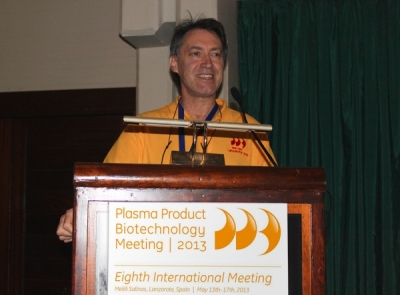 Anti A/Anti B hemagglutinins in IVIG products to avoid undesirable clinical and haematological side-effects. That topic was discussed more in detail by Christophe Segard and Catherine de Coupade from LFB in the Manufacturing and Quality sessions.
Anti A/Anti B hemagglutinins in IVIG products to avoid undesirable clinical and haematological side-effects. That topic was discussed more in detail by Christophe Segard and Catherine de Coupade from LFB in the Manufacturing and Quality sessions.
On the topic of Pathogen Safety, Sally Bayliss from Paul Ehrlich Institute explained the background of the hepatitis E virus (HEV) and how this virus now can be found in blood and plasma donors around the world. She stressed that efforts should be made to better control the presence of HEV by harmonization of the worldwide assays and possible also implementing heat treatment to the relevant plasma products to inactivate the virus. In the Pathogen Safety session an illustrative presentation was given by Jun Adan-Kubo from the Japanese Blood Products Organization. He elaborated on the mechanism of virus removal in nano-filtration where transmission electron and fluorescence microscopy were used to study the distribution of the model virus in the filter. The results gave some insight to the mechanism behind the filtration process and could contribute to a better design of the next generation of nanofilters.
The still unknown details of the mechanisms for IVIG have been reviewed throughout the last three PPB meetings, and still continue to spark an intense discussion. In a focus lecture Alan Lazarus from Canadian Blood Services presented “Mechanisms of action of IVIg: What do we really know?”In this lecture he presented research on IVIG and Idiopathic Thrombocytopenic Purpura (ITP). IVIg has shown beneficial effects in a large number of seemingly unrelated autoimmune diseases and inflammatory states. However, Alan stated that we still don’t really know how IVIg works and the IVIg puzzle has been difficult to solve with results that often seem to be in conflict with each other. One hypothesis discussed by Alan was that IVIg may interact with activating FcRs on dendritic cells in the initiation of its effects.
Jan Over from Sanquin gave an insightful presentation on orphan drugs. Orphan drugs are medicinal products for diagnosing, preventing or treating rare diseases, with a prevalence as low as 0.65 persons/1,000 individuals. There are about 5000 to7000 rare diseases world-wide, with some 250 new ones identified annually. Even if they are referred to as rare diseases, they are still affecting > 55 million people in the US and Europe. Jan Overs talked about the necessity of regulatory pathways for orphan drugs, but discussed also the complexity of the definition of orphan drugs as well as price and the exclusivity terms.
In the session about Commercial and Market Trends, Pierre Francois Falcou from LFB shared some valuable insights and experiences around the difficulties in technology transfer from the already established companies in Europe and USA to the emerging markets in order to support a more domestic plasma fractions industry. The key